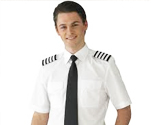How to Become a Pilot

Pilots fly aircraft like planes and helicopters. Professional pilots may work for airlines transporting people, for shipping companies transporting goods, or for police departments, fire departments, and other rescue organizations assisting with emergencies.
To fly a plane or helicopter, pilots must know how to use the controls of the aircraft they are flying, read the instruments that reveal information about the state of the aircraft, and react quickly and correctly to any weather or mechanical issues that may arise. Pilots typically work in teams, including the captain, co-pilot, and additional crew like flight attendants. They also communicate and work with passengers, baggage handlers, aircraft mechanics and technicians, and air traffic controllers.
What kind of training is required to become a pilot?
Becoming a pilot requires extensive training. Some pilots receive their training through the military, but others pay to train with a private flight school. Flight schools offer professional pilot programs that take students with no flying experience and help them progress to the point where they are eligible to be hired to fly.
Students in flight schools first work on small single-engine planes or on helicopters, if they are at a helicopter flight school. They learn the fundamentals of flight, including take-off, level flight, turns, and landing.
Once these basics are mastered, students learn how to use the plane’s instruments to guide flight. This knowledge enables pilots to fly in clouds and bad weather. Federal Aviation Administration (FAA) rules prohibit pilots from flying in certain conditions unless they hold an “instrument rating.”
Pilots in flight school also learn how to respond to stalls and other emergencies, make advanced maneuvers, follow traffic patterns, use aircraft navigation systems, perform take-offs and landings in difficult conditions, and fly multi-engine airplanes (if learning to fly airplanes). Students learning to fly helicopters may also learn how to transport external loads.
Flight schools use hands-on instruction with their students by taking them on real flights, either with instructors or solo, and using flight simulators.
Are there any certification or licensure requirements?
The FAA governs the licensure of pilots, and there are several certificates and ratings that pilots must earn on their way to becoming a commercial or airline pilot. Earning a new certificate or rating involves completing a number of hours of flight training, and passing knowledge and practical tests, called check rides. Candidates are also required to present medical certificates issued by an aviation medical examiner. These medical certificates show that pilots are not using drugs and that they meet standards for vision, hearing, balance, and mental health.
New pilots start by working toward a private pilot certificate, which allows them to fly small planes solo. After earning a private pilot certificate, student pilots work toward earning an instrument rating, which allows them to fly solo in adverse weather conditions, and a multi-engine rating, which allows them to fly planes with more than one engine.
A commercial pilot license allows pilots to take payment in return for their services, so earning one is necessary to becoming a professional pilot. Pilots who want to work for airlines must also earn an airline transport pilot certificate. Many students in flight school programs earn single-engine, multi-engine, and instrument instructor certificates on their way to their commercial license.
How long does it take to become a pilot?
The amount of time it takes to work your way up to a commercial or airline pilot certificate depends on your method of training. You could complete certificate training programs at your own pace, attend an accelerated program that allows you to earn each certificate in just a few weeks, or enroll in an “academy” that takes 12 months to complete.
What does a pilot earn?
The median yearly pay for pilots in the United States was $114,200 in 2012. The top 10 percent of earners in this field made more than $187,200 and the lowest 10 percent made less than $66,970 that year.
The Bureau of Labor Statistics (BLS) reports that airline pilots can expect to earn around $20,000 their first year, and that pay increases with experience. There is also major difference in pay between regional and major airlines.
What are the job prospects?
The BLS projects that employment of commercial and airline pilots will actually decrease by 7 percent between 2012 and 2022 due to cost-saving measures by airlines. While more jobs are not expected to be created over the next several years, jobs will become available as pilots retire. Job prospects may be better with regional airlines and smaller aviation services.
What are the long term career prospects for pilots?
As they gain experience, pilots can move up the ladder at their airline, working as a first officer, and then a captain. Building flight hours with larger airplanes can earn pilots at regional airlines the opportunity to work with a major airline.
How can I find a job as a pilot?
Earning a job with a major airline can be difficult if you don’t have experience. Military pilots have significant experience, but fewer are becoming civilian pilots in recent years. Some flight academies are associated with airlines, and if you complete one of these programs, you may have a job offer after you graduate.
Otherwise, you can gain the experience you need by first looking for work in commercial flight, teaching at a flight school, or working as a charter pilot.
If you fly helicopters, you can look for jobs with police departments, fire departments, medical rescue organizations, news organizations, tourism agencies, or offshore oil and gas operations.
How can I learn more about becoming a pilot?
The FAA has published several aviation handbooks and manuals that you can find online, including a student pilot guide that describes the process of becoming a student pilot.